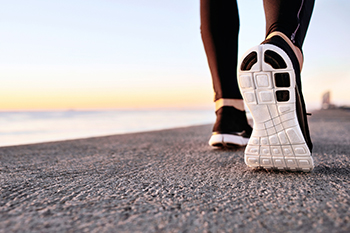
If you walk for exercise, it’s a good idea to check out which kind of shoe is best for you. However, according to experts, if running is your main exercise activity, another type of shoe is recommended. The four main differences between walking and running shoes are the sole, the heel, motion control, and weight. Walking shoes are more flexible, and running shoes are stiffer, in addition to having a thicker wedged heel for extra cushioning. The opposite is true for walking, as thicker heels can invite shin splints or tendonitis. They may also cause you to trip while taking a step. With running shoes, stability is a major concern, and not as much with a walking shoe. In general, walking shoes are heavier than running shoes, which need to be lightweight so as not to hinder speed. With either type of shoe, experts believe a proper fit is essential. Avoid shoes that are too tight, too big, too wide, or too narrow. If you would like more information on the proper shoe for your activity, it is suggested that you consult with a chiropodist.
Finding the right shoes can sometimes be a major hassle, especially if you intend to work out in them. There are shoes on the market designed specifically for running and walking, but it can be difficult to differentiate between the two and find the right shoes for you. If you’re having trouble finding the right shoes, please consult with Chiropodist Stephanie Poupore from North Bay Foot & Ankle. Our clinician can help you maintain the health of your lower limbs and your mobility.
What are the differences between running and walking shoes?
These two types of shoes vary along several parameters.
-
Cushioning: Runners need more cushioning in the heel and forefoot areas of the shoe, while walkers can get away with less cushioning.
-
Heel height: Runners need a higher heel to provide them with stability, but the ideal height of the heel for runners varies depending on their running gait. Walkers generally don’t need a built-up heel.
-
Heel flare: Flared heels can help provide extra stability for runners with certain gaits, while walkers may benefit from a flared heel to control the motion of their foot.
-
Flexibility: Both runners and walkers need shoes that are flexible.
For more information about the differences between walking and running shoes, and to figure out which shoes may be right for you, please consult with a chiropodist. Feel free to contact our office located in . We offer the newest diagnostic and treatment technologies for all your foot care needs.
